Cape Town Update

Aurora_b
Mike and Liz Downing
Wed 29 Jan 2014 19:55
|
Still in the Royal Cape Town marina and it's been a
busy couple of weeks trying to get as much as possible done on the
boat. The weather has been tremendous for working outside; it's the best spell
of fine weather we've had for years. Virtually every day we wake up to blue
skies and it stays sunny and hot all day, but it cools down at
night so it's easy to sleep. At this time of year with the sun in the
south, it stays light until 8 o'clock in the evening, so the days are long and
we end up working late without realising it. So far the weather here tops both
Australia and New Zealand, but it could just be that we've picked a good year,
which we definitely didn't in the other two. The downside is the wind - at the
drop of a hat it can go from being calm to blowing 30-40kts. Generally not a
problem when working on the boat, except everything has to be tied down or it's
gone in a matter of seconds. And that includes the boat! We have quadruple lines
on the bow and stern, and double lines for springs.
The two major jobs are replacing the rigging and
replacing the sprayhood and bimini. The rigging is virtually complete, with all
shrouds now in place. We're using dyform throughout (apart from the running
check stays) as it's supposed to be 30% stronger (and, or course, is 30%
more expensive!). If we had a strength issue with the previous rigging,
then the extra strength will help. If it was more of a fatigue issue,
then it might not, but whatever, hopefully it will last a good while (that is
if we don't cross the Indian Ocean every other day!). The one rigging
job still to do is to replace the sheaves at the top of the mast which the main
halyard and topping lift use (one is no longer round!) To do this
seemingly simple task, the top of the mast has to come off. Not easy when
the mast is still up. But the rigging guys here reckon they stand a chance
of doing it, so fingers crossed. The sprayhood and bimini have been
trial fitted a couple of times and it's getting closer. In Australia we created
a prototype combination where we actually join the sprayhood and bimini
together with a clear panel so we stop rain, and waves going up over the
sprayhood and into the cockpit. It worked well on the passages from
Australia and saved the cockpit (and us in it!) from several drenchings (or
early baths, as one BBC commentator used to say). The prototype was joined by
lashings and these are being replaced with proper zips, making it much
easier to use and it should look much less of a Heath Robinson construction. At
least we hope it will.
Other things have included fixing the VHF cockpit
repeater, requiring several solder joints. Soldering is not one of my top skills
and despite following all the tips in the books and on U-Tube, the solder
still refuses to go where it's supposed to! However, I did it. The internal
working doesn't look pretty, but that's hidden and it does now work. The
windlass has been a more significant issue. It's been playing up -
sometimes it works and sometimes it doesn't. Up until now, when it didn't,
repeatedly hitting the switch or turning the drum by the emergency handle would
get it going again, but this weekend it seemingly died completely. We have 90
metres of chain - that's a hell of a lot to pull up by hand, so getting it fixed
is critical. The conclusion of engineers here is that it's electrical and the
simple thing to change was the control box. That didn't solve it and the motor
is now believed to be the culprit and has been taken out and is with a
repair shop in Cape Town. From what they've seen they are sure that's
the problem and are going to refurbish it. So fingers crossed on that one
too. We had thought of getting a new windlass as we're so dependent on it, but
they're very expensive and they can't get one here for at least 6
weeks. We can't wait that long.
Another big job was taking the boat out of the water on
the slip they have here. They have a crane, but we're too heavy for that. The
slip is good as it makes it easier to antifoul with no boat props in the way,
but there's always a queue to use it so time on it is very limited. We were out
and back in within 4 days. Not strictly true as we went back on the 5th day, but
that was only because it was too windy to re-launch us. We spent all of the
morning on the day we were due to go back in the water waiting for a
lull, but it never came and the boat yard crew gave up shortly after lunch. If
it's too windy the slip cradle gets blown off its railway tracks once the weight
of the boat comes off it, so not a good idea! We did manage to do most
of what we wanted - antifoul, check and grease the feathering
propeller and rudder bearing, and change all the anodes. Well not all the
antifouling. As said before, we have 3 different types of antifouling -
2 lines of hard antifouling along the waterline (so we can scrub it if we
have to) and the rest self eroding, so soft. For the latter we use Micron 66
which they don't have in South Africa and if we use what they do have we
would have to put a barrier coat over it if we ever wanted to go back to Micron
66. That didn't appeal, so apart from a gentle wipe to get rid of the scum
on it (there were no barnacles at all) we've left it and hope it will last until
we reach somewhere where they do have Micron 66. The time consuming part of the
antifouling is masking up for the lines round the waterline and that's all done,
so antifouling the bottom should be straightforward and quite quick (relatively
speaking!).
However, we have managed to get away from the boat
a few times. On a beautiful day with not a breath of wind, we made it to
the top of Table Mountain. Remarkably there was no wind at all up there either
and with not a cloud in the sky you could see for miles. Going up on the cable
car was quite an experience too. It's not something that we do that often and
this one holds 60 odd people and the floor revolves 360 degrees as you go up, so
every one gets a 360 degree view. It does mean that you can't hold on which is a
little disconcerting to start with, but with no wind it wasn't a problem.
We also got the opportunity to drive round False Bay and visit places en route,
including a Cheetah sanctuary where we got to learn all about how endangered
they are, and to get close up and stroke one. They are wonderful creatures
and purr like domestic cats, but are a bit big to have curled up on the rug in
front of the fire! The Kirstenbosch botanical gardens in Cape Town was also on
the list and it was another lovely day. The Gardens are right up against Table
Mountain and are one of the best in the world. Unfortunately it wasn't the time
of year for the Proteas to be out, but it was a very beautiful, interesting and
tranquil place. As with most things here, it would be good to have longer.
Staying more than your allotted time in South Africa is not easy with all the
bureaucracy you have to go through, so very few people attempt it. One of the
problems here is that different officials interpret the rules differently and
what one says one day, another will disagree with the next.
Most of the people we know have now left and are on
their way north, but a couple are still making their way from Richard's Bay, so
we might meet up with them in a couple of weeks or so. We shall
see.
 Aurora B out of the water on the slipway
with Table Mountain behind.
As can be seen, there is nothing of any size between the
Mountain and the marina, so nothing to stop the wind which roars down whenever
the 'table cloth' (cloud) forms on the top. As labour is not too
expensive, we arranged for the boatyard staff to put the scaffolding
up and clean the topsides. We then did the easy bit
of applying a coat of wax. It's nice to see her shine once
again!
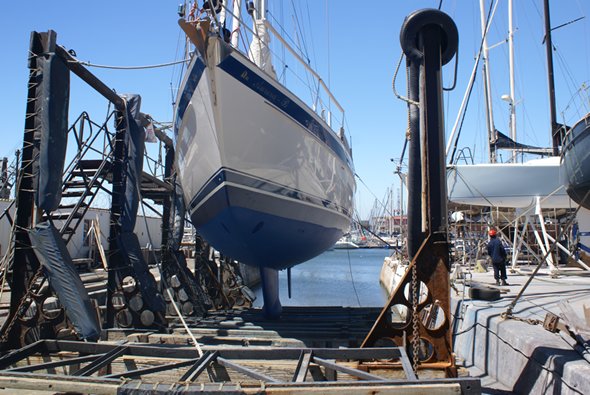 The slipway cradle has tie-ups on one side
only, so you feel just a little exposed on the
other side! This shows the white antifouling line above the
waterline, the blue band on
and below the waterline and the rest of the hull that we didn't antifoul.
Hope we made
the right decision and it
lasts until we find somewhere that
stocks Micron 66.
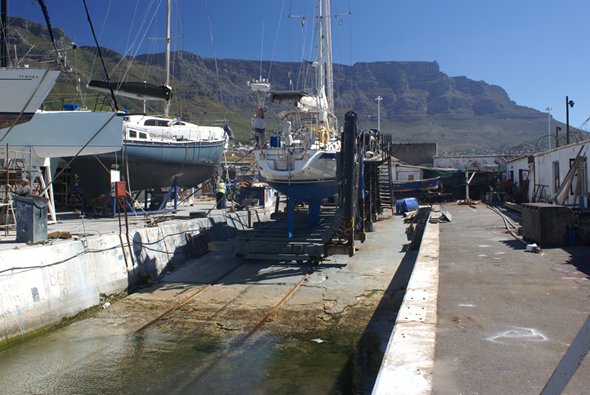 A cloudless day over Table Mountain (so no
wind!).
 The shine of the HR blue line! It comes up
really well whether we use a machine polisher
or just do it by hand.
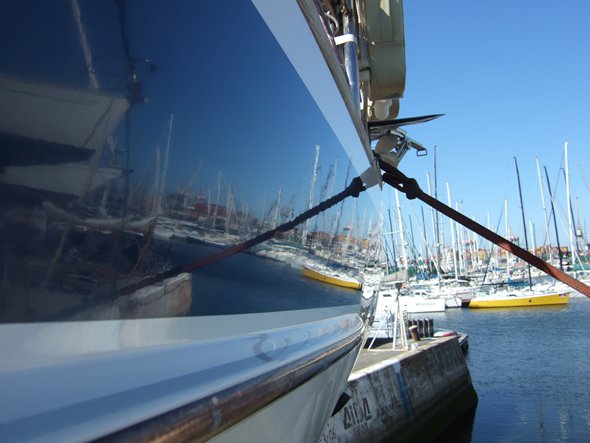 Looking the other way. Both
pictures show the tie-downs (and their reflections) which
all boats in the yard have
to help ensure they don't get blown over when the wind comes
down the mountain.
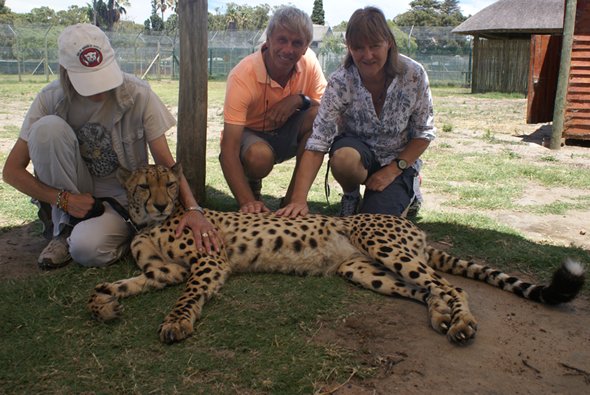 Truly magnificent creatures. With only
7,500 left in Africa,
time is running out for
them.
We did our bit in the souvenir
shop (everything with
cheetahs on) as the profits all go to
keep the centre
running.
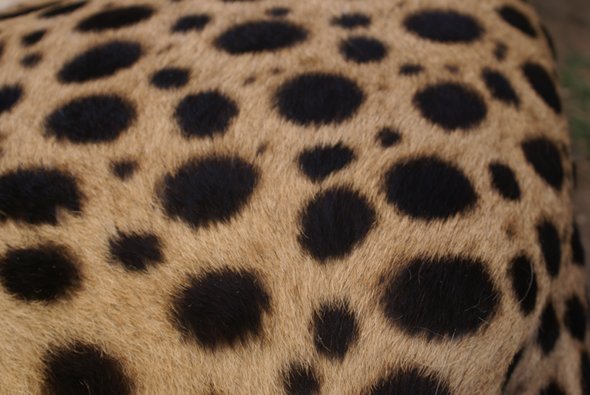 The fur is actually quite
coarse.
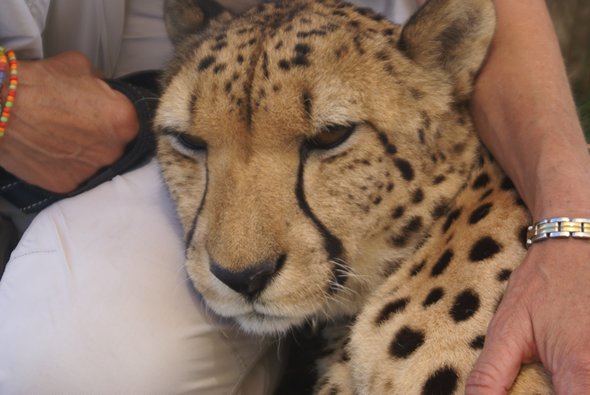 AAAH!
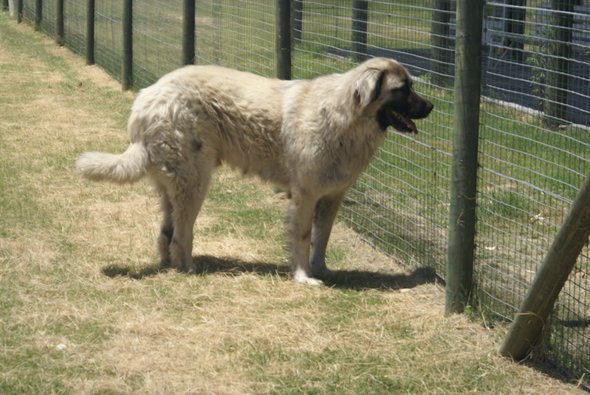 Why the (very big!) dog? The cheetah
centre breeds these dogs to help protect the cheetahs,
in a roundabout way.
One of the main causes of cheetah deaths is being shot,
trapped or poisoned by farmers wanting to protect their livestock. Most of the
livestock deaths are not due to cheetahs, but they get the blame for it and
suffer. These are the Turkish Anatolian Shepherd dogs that instinctively protect
the herd they are brought up with. So the cheetah centre breeds them and when
they're 6 to 8 weeks old they are given to farmers to raise with the herd
they want to protect. One of conditions the farmers have to agree to when
taking a dog is that they won't put traps and poison down. The dogs are bigger
than Alsatians and considerably bulkier - you would not want to upset one!
Apparently they don't make good pets as they're so protective they wouldn't let
anyone near you - friend or foe!
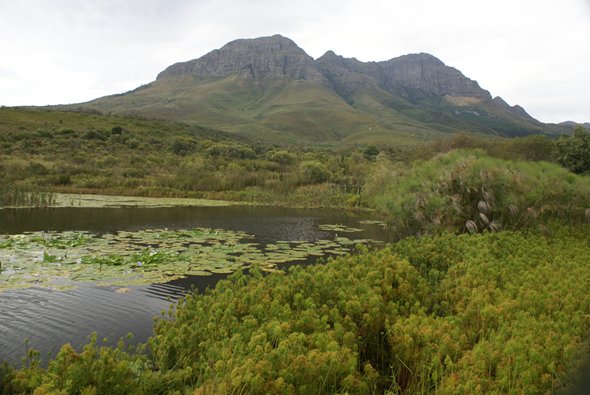 The Helderberg Nature Reserve on the
southern slopes of the Helderberg Mountains.
It's to the north east of False Bay, and as far as we drove
to the east.
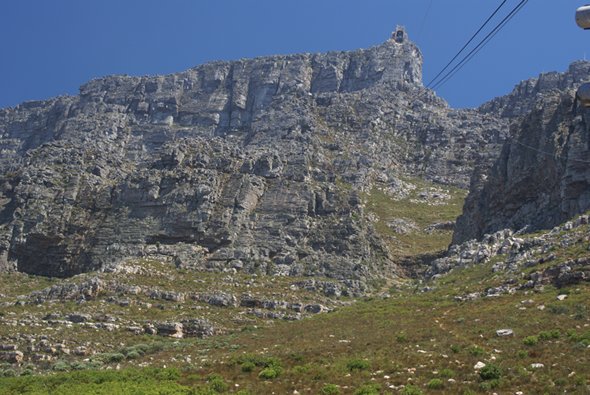 The cable car ride up the face of Table
Mountain to the building right at the top.
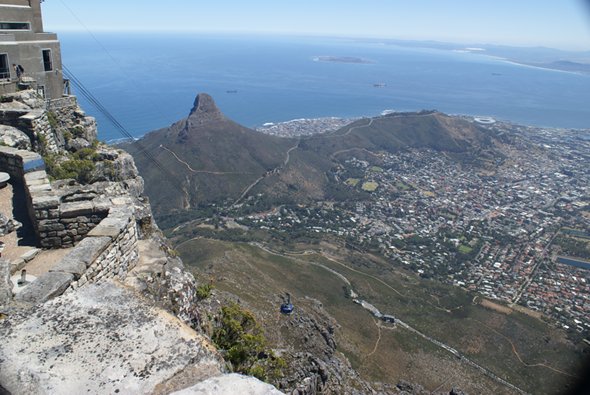 Made it! 1084.6 metres, or
3,558ft, and what a view! The island in the distance is Robben
Island where Nelson Mandela was imprisoned.
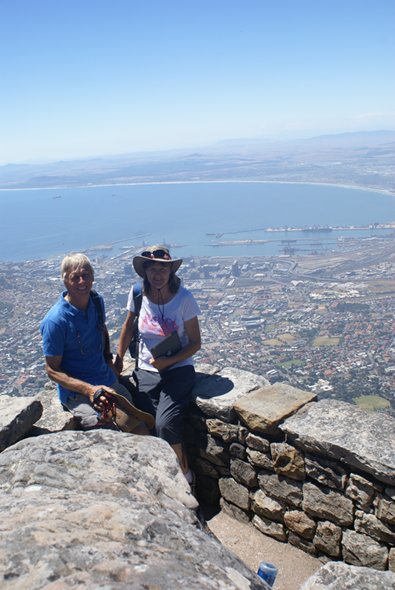 We went mid-week with not a lot of people
about, but we did find
someone to take this. And of course we
reciprocated!
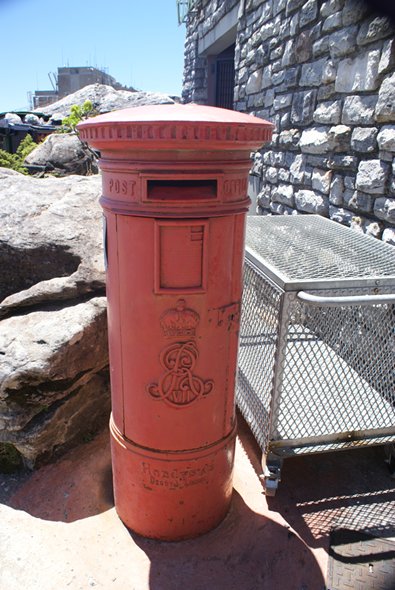 An Edward VII post box at the top for
sending mail with a Table
Mountain frank. We sent ourselves a
postcard so hope it finds
its way to the
UK.
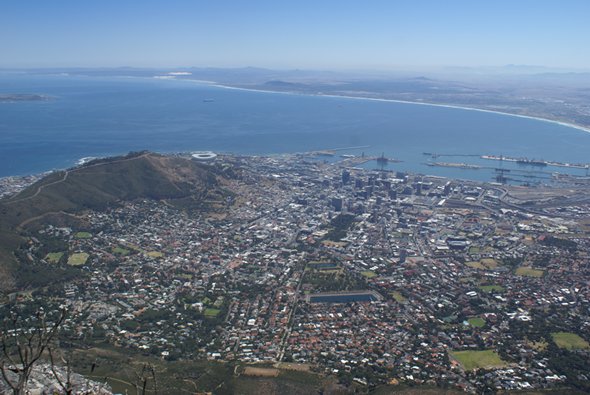 The centre of Cape Town.
The marina is in the dock area to right. The stadium to the
left was built for the 2010 World Cup.
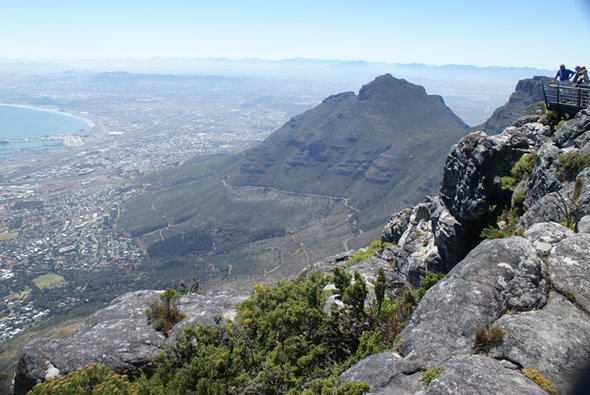 Looking across to the mountains in the
distance. The mountain in the foreground is Devil's
Peak. There are various trails to follow around Table
Mountain and if feeling energetic
it's possible to walk down rather than go via the cable car. If
feeling exceptionally
energetic it's possible to walk up.
Needless to say we took
the cable car both ways!
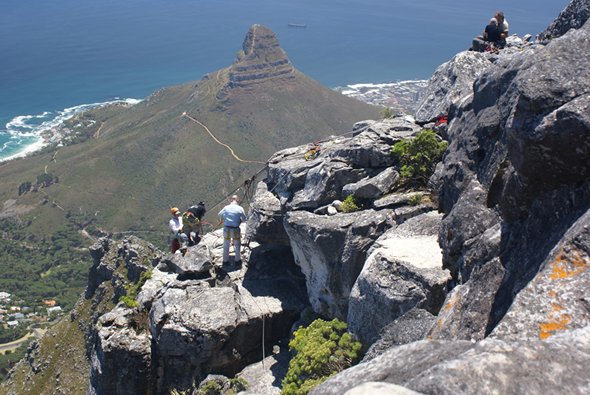 Looking across to the next peak - the Lion's
Head. Absailing over the edge was on offer
for those brave enough (or mad enough!) to try. The top of
the mast is the
highest I want to trust my
life to a
rope!
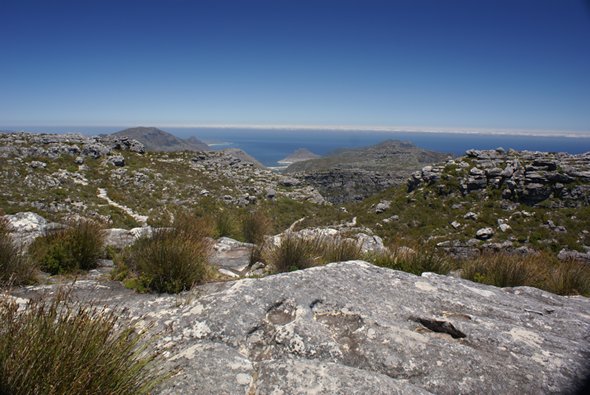 The plateau on the top, looking out across
the sea to the south west.
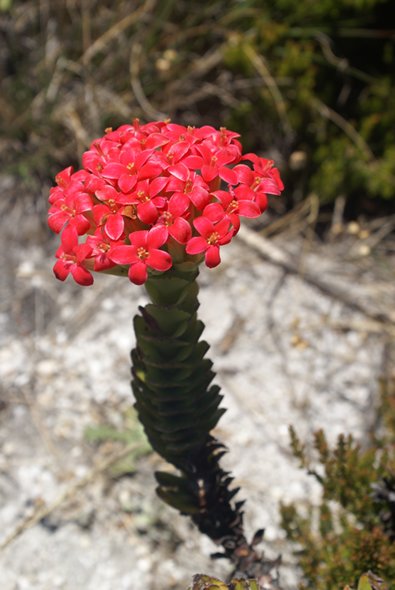 Fynbos on the top - natural shrubland
vegetation occurring around the
Cape Peninsula.
 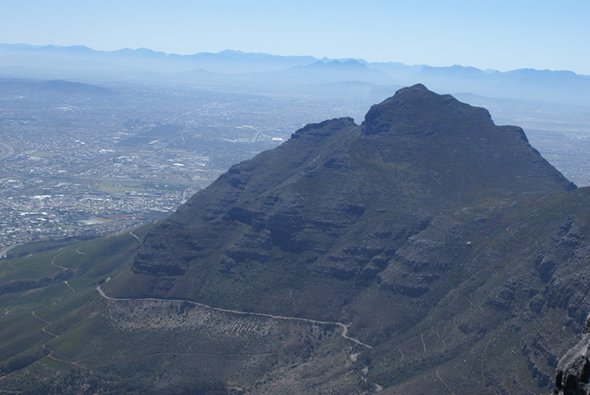 A close-up of Devil's
Peak.
 And now on the other side of Table Mountain,
in Kirstenbosch Botanical Gardens.
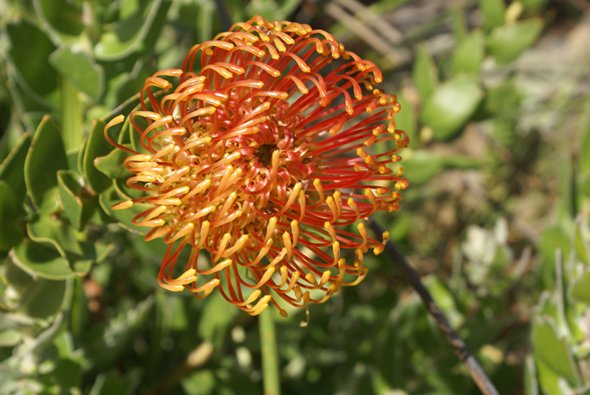 It's not the time of year for Proteas, but
this pin cushion is from the Protea family and
the closest we came to seeing one in flower.
 The gardens were just a beautiful and
tranquil place to spend a summer afternoon.
 Possibly a
conebush.
 Again, another mid-week day and we had the
gardens almost to ourselves. It was quiet
enough for this snake to appear from the flower borders just in front
of us and make
it's way across the lawns.
We think it was a boomslang, which on
looking it up afterwards,
is venomous. So just as well we didn't
get too
close!
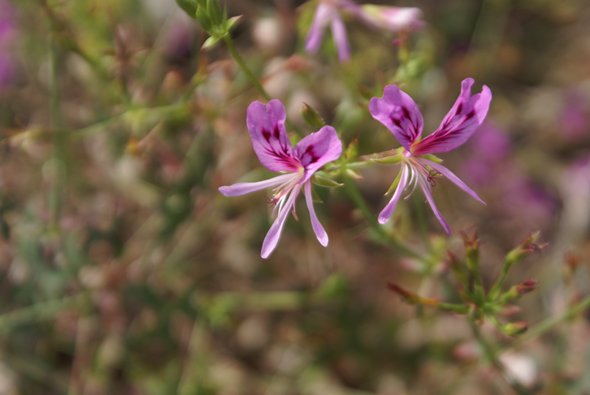 A pelargonium - a native of South
Africa.
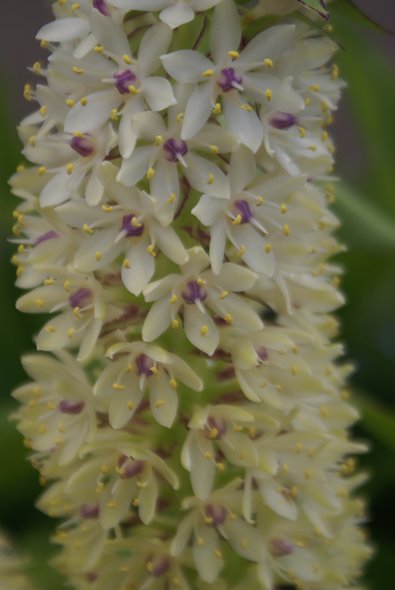 Quite stunning - still trying to find out
what this is!
|